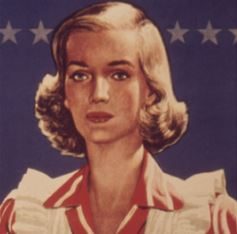“In various parts of Missouri, one hears the story of a great hole in the ground, where hunters have heard strange sounds and smelled unusual odors. Some say the Devil lives in that hole …”
–Missouri Magic and Folklore by Randolph Vance, 1947
Once upon a time, as absurd as it sounds, the King of Spain owned this land.
For reasons unknown, he gifted it to a French fur trader named Jules DeMun, who gave this neighborhood its name. In the 1920s it was acquired by Henry Wright, a landscape architect who wanted to test his “new town” philosophy of community planning. He envisioned an inward-facing realm of tidy apartment buildings. Here is a Juliet balcony, there is a blank coat of arms. One roof might be pitched, one might be flat, one might have a witch’s hat. But they all have six apartments each. They all have three floors. And they are all made of the identical brick that characterizes this town. “Brick City,” St. Louis is sometimes called.
There is a school. There are shops. There is a playground. From the seminary that bounds us to the west, a tuneless bell mentions the hours. Eight big city blocks.
Here we are then, on top of the highest point in the municipality, just as Henry wanted us, right where he put us. We sit as in a wooden kitchen chair, our legs crossed at the ankles, trying not to be tall poppies. We curl into ourselves, into each other, nodding. We hear but do not comment on our neighbors’ lives through the walls, the music and the anger. We step down the narrow alleys that divide us on our way to the laundromat or the mailbox. You might find us licking ice cream on the bench outside the playground. Our dogs nose the squares of grass in the easements. Our life is an easement. Easy.
Our dogs forever pull us east, east, east! All day they wait, sleeping on De Mun’s hill, behind the balconies and turrets, dreaming of the east. When we leave our beds in the morning, smelling neighbor coffee, hearing earlier risers enact their hope, our dogs begin tracking our movements, calculating the likelihood of a woodswalk. They follow us around the place, sending telepathic pleas. “Woods, woods, woods!” they say, as we hurl from bed to bathroom to kitchen, trying to sort out what to do first, trying to begin. “Deer scat!” they say. “Heirloom grasses! Rot! The vomitous jam of fallen ginkgo fruit! All the matter owls cannot digest which they spit out in dense pellets of fur and bone! Acorns, both with and without taproots, both with and without worms! East!”
We know what they want. To the east is the park, the center of the city, bigger even than Central Park in far New York, and every bit as elder and handsome. There is a “reclaimed” prairie, tended carefully by a team of urban naturalists. There is a pathed wooded area just big enough to feel remote, at least in summer when the oaks have leaves. We have been informed that it provides an important habitat for migratory birds. Yes, we see that it does! We believe it! We can walk through these woods and emerge at an art museum built for the 1904 World’s Fair. We’re lucky, we tell each other, so lucky to live here. We walk in this park every day when the weather is good. We text each other: Fancy a walk? Leaving in five. But not today. Some of us must Zoom inside Henry Wright’s bricks today. We’re on our own today. Encircling the ecstatic dogs with harnesses, we ford the river of Skinker Boulevard. We’ll read in the woods. Missouri Magic and Folklore. Perfect.
Yes, we cross the river and head up the hill, into the place where the light is different. Past a wasp nest, a pair of woodpeckers, past the Osage orange tree with the low branch that The Girl used to swing on. The land drops away, down to a creek bed and the buildings and roads are gone. Around a bend and the dogs won’t give up a smell. We wait for them, book in our face, dragging them a bit, step by step. We turn the pages while they read the earth, noses adhered to dirt.
This is when we first see him in the blur behind the pages. We do not turn to him. There is no need. He is not an uncommon sight. We do not look at him yet. We do not worry about him. Without leaving the sentence we’re reading, we half-see a bicycle leaning against a tree behind him. The outline in our peripheral vision is familiar, a man resting under a tree from a ride in the park. We fill in the details. A prosperous youngish person who will end the afternoon in an office at Wash U or picking up his third grader at 3 p.m. Holding something, a phone, probably. When we get closer, as the dogs progress toward him, we will need to decide whether to greet him or not, but not yet. Possibly, we know him.
We do not know why the dogs never react, why they stand and stare with us. Maybe their breath stops, too, when we finally lift our eyes to say good morning. We are seeing him as he really is now, manifested in the woods. We are seeing naked flanks, crouching, one fist between his legs, moving and moving. We look at the face and find it is already looking at our own, moving and moving and grinning and grinning, wanting to be seen.
We can still hear the freeway. We will always be able to hear the freeway because the freeway is forever. But now, behind the bicycle, here is a mink streaking red in the underbrush, on the run forever from Jules De Mun’s ghost! This is what we have of wildness. Here is what we know of the Devil.
 Nancy Bell is a multidisciplinary theatre artist working in St. Louis. Her eight contemporary re-imaginings of Shakespeare were produced at St. Louis Shakespeare Festival, where she was Playwright-In-Residence for seven years. Her plays with novelist Peter Grandbois were produced at 59E59 in New York and California Repertory. Website: www.NancyEllenBell.com.
Nancy Bell is a multidisciplinary theatre artist working in St. Louis. Her eight contemporary re-imaginings of Shakespeare were produced at St. Louis Shakespeare Festival, where she was Playwright-In-Residence for seven years. Her plays with novelist Peter Grandbois were produced at 59E59 in New York and California Repertory. Website: www.NancyEllenBell.com.
